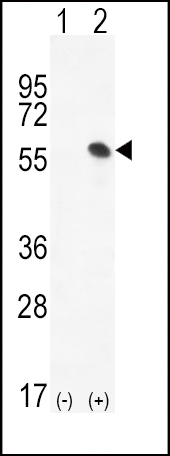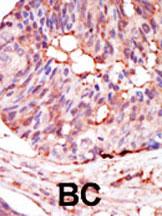PFKFB3 Antibody (N-term)
Purified Rabbit Polyclonal Antibody (Pab)
- 产品详情
- 文献引用 : 1
- 实验流程
- 背景知识
Application
| WB, IHC-P, E |
|---|---|
| Primary Accession | Q16875 |
| Other Accession | O35552 |
| Reactivity | Human, Mouse |
| Predicted | Rat |
| Host | Rabbit |
| Clonality | Polyclonal |
| Isotype | Rabbit IgG |
| Calculated MW | 59609 Da |
| Antigen Region | 1-30 aa |
| Gene ID | 5209 |
|---|---|
| Other Names | 6-phosphofructo-2-kinase/fructose-2, 6-bisphosphatase 3, 6PF-2-K/Fru-2, 6-P2ase 3, PFK/FBPase 3, 6PF-2-K/Fru-2, 6-P2ase brain/placenta-type isozyme, Renal carcinoma antigen NY-REN-56, iPFK-2, 6-phosphofructo-2-kinase, Fructose-2, 6-bisphosphatase, PFKFB3 |
| Target/Specificity | This PFKFB3 antibody is generated from rabbits immunized with a KLH conjugated synthetic peptide between 1-30 amino acids from the N-terminal region of human PFKFB3. |
| Dilution | WB~~1:1000 IHC-P~~1:100~500 E~~Use at an assay dependent concentration. |
| Format | Purified polyclonal antibody supplied in PBS with 0.09% (W/V) sodium azide. This antibody is prepared by Saturated Ammonium Sulfate (SAS) precipitation followed by dialysis against PBS. |
| Storage | Maintain refrigerated at 2-8°C for up to 2 weeks. For long term storage store at -20°C in small aliquots to prevent freeze-thaw cycles. |
| Precautions | PFKFB3 Antibody (N-term) is for research use only and not for use in diagnostic or therapeutic procedures. |
| Name | PFKFB3 |
|---|---|
| Function | Catalyzes both the synthesis and degradation of fructose 2,6- bisphosphate. |
| Tissue Location | Ubiquitous. |
For Research Use Only. Not For Use In Diagnostic Procedures.

Provided below are standard protocols that you may find useful for product applications.
BACKGROUND
PFKFB (6-phosphofructo-2-kinase/fructose-2,6-bisphosphatase) is a bifunctional enzyme, having both kinase and phosphatase activities residing on the same enzyme subunit but having distinct active sites. PFKFB regulates the steady-state concentration of fructose-2,6-bisphosphate, a potent activator of a key regulatory enzyme of glycolysis, phosphofructokinase. To date, four PFKFB isozymes (PFKFB 1-4) have been described, which show differences in their tissue distribution and kinetic properties in response to allosteric effectors and hormonal signals. Among the PFKFB's PFKFB3 has the highest kinase:phosphatase ratio, in part because it lacks the characteristic serine phosphorylation site near the N-terminal that down-modulates kinase activity. PFKFB3 was first described in the rapidly growing placenta. The glucolitic rate in placenta is accelerated by anoxia and by maternal diabetes. Cancer cells maintain a high glycolytic rate even in the presence of oxygen, a phenomenon known as the Warburg effect. The glycolytic rate in the placenta, another fast-growing tissue, is accelerated by anoxia and by maternal diabetes.
REFERENCES
Navarro-Sabate, A., et al., Gene 264(1):131-138 (2001).
Chesney, J., et al., Proc. Natl. Acad. Sci. U.S.A. 96(6):3047-3052 (1999).
Sakakibara, R., et al., J. Biochem. 122(1):122-128 (1997).
Hamilton, J.A., et al., Mol. Endocrinol. 11(4):490-502 (1997).
Sakai, A., et al., J. Biochem. 119(3):506-511 (1996).
终于等到您。ABCEPTA(百远生物)抗体产品。
点击下方“我要评价 ”按钮提交您的反馈信息,您的反馈和评价是我们最宝贵的财富之一,
我们将在1-3个工作日内处理您的反馈信息。
如有疑问,联系:0512-88856768 tech-china@abcepta.com.






















 癌症的基本特征包括细胞增殖、血管生成、迁移、凋亡逃避机制和细胞永生等。找到癌症发生过程中这些通路的关键标记物和对应的抗体用于检测至关重要。
癌症的基本特征包括细胞增殖、血管生成、迁移、凋亡逃避机制和细胞永生等。找到癌症发生过程中这些通路的关键标记物和对应的抗体用于检测至关重要。 为您推荐一个泛素化位点预测神器——泛素化分析工具,可以为您的蛋白的泛素化位点作出预测和评分。
为您推荐一个泛素化位点预测神器——泛素化分析工具,可以为您的蛋白的泛素化位点作出预测和评分。 细胞自噬受体图形绘图工具为你的蛋白的细胞受体结合位点作出预测和评分,识别结合到自噬通路中的蛋白是非常重要的,便于让我们理解自噬在正常生理、病理过程中的作用,如发育、细胞分化、神经退化性疾病、压力条件下、感染和癌症。
细胞自噬受体图形绘图工具为你的蛋白的细胞受体结合位点作出预测和评分,识别结合到自噬通路中的蛋白是非常重要的,便于让我们理解自噬在正常生理、病理过程中的作用,如发育、细胞分化、神经退化性疾病、压力条件下、感染和癌症。







